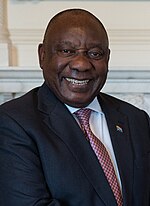
Back President van Suid-Afrika Afrikaans رئيس جنوب إفريقيا Arabic Presidente de Sudáfrica AST Predsjednik Južnoafričke Republike BS President de Sud-àfrica Catalan سەرۆک کۆماری ئەفریقای باشوور CKB Seznam představitelů Jižní Afriky Czech Arlywydd De Affrica Welsh Sydafrikas præsidenter Danish Präsident der Republik Südafrika German
| President of the Republic of South Africa | |
|---|---|
10 other official names
| |
 Presidential seal | |
| Government of South Africa | |
| Style | Mr. President (informal) His Excellency (formal, diplomatic) |
| Type | |
| Member of | Cabinet |
| Residence | Mahlamba Ndlopfu (Pretoria) Genadendal (Cape Town) Dr. John L. Dube House (Durban) |
| Seat | Union Buildings |
| Appointer | National Assembly of South Africa |
| Term length | Five years, renewable once |
| Constituting instrument | Constitution of South Africa |
| Precursor | State President |
| Formation | 10 May 1994 |
| First holder | Nelson Mandela |
| Deputy | Deputy President |
| Salary | R 3,900,000 annually (2019)[1] |
| Website | www |
| Zulu | Umongameli waseNingizimu Afrika |
|---|---|
| Xhosa | uMongameli waseMzantsi Afrika |
| Afrikaans | President van Suid-Afrika |
| Sepedi | Mopresidente wa Afrika Borwa |
| Swazi | Moporesitente wa Aforika Borwa |
| Sesotho | Mopresident wa Afrika Borwa |
| Setswana | Puresidente wa Afrika-Dzonga |
| Xitsonga | uMengameli weleNingizimu Afrika |
| Venda | Muphuresidennde wa Afrika Tshipembe |
| Southern Ndebele | uMongameli weSewula Afrika |
| This article is part of a series on the |
| Politics of South Africa |
|---|
 |
|
|
The president of South Africa is the head of state and head of government of the Republic of South Africa. The president directs the executive branch of the government and is the commander-in-chief of the South African National Defence Force. Between 1961 and 1994, the office of head of state was the state presidency.
The president is elected by the National Assembly, the lower house of Parliament, and is usually the leader of the largest party, which has been the African National Congress since the first multiracial election was held on 27 April 1994. The Constitution limits the president's time in office to two five-year terms.[2] The first president to be elected under the new constitution was Nelson Mandela. The incumbent is Cyril Ramaphosa, who was elected by the National Assembly on 15 February 2018 following the resignation of Jacob Zuma.
Under the interim constitution (valid from 1994–96), there was a Government of National Unity, in which a member of Parliament (MP) from the largest opposition party was entitled to a position as deputy president. Along with Thabo Mbeki, the last apartheid president, F. W. de Klerk also served as deputy president, in his capacity as the leader of the National Party which was the second-largest party in the new Parliament. But De Klerk later resigned and went into opposition with his party. A voluntary coalition government continues to exist under the new constitution (adopted in 1996), although there have been no appointments of opposition politicians to the post of deputy president since.
The president is required to be a member of the National Assembly at the time of the election. Upon election, the president immediately resigns their seat for the duration of the presidential term. The president may be removed either by a motion of no-confidence or an impeachment trial.
- ^ "Ramaphosa's salary vs other world leaders". businesstech.co.za. 15 March 2019. Retrieved 22 March 2021.
- ^ "Constitution of the Republic of South Africa, 1996 - Chapter 5: The President and National Executive, 88. Term of office of President".
